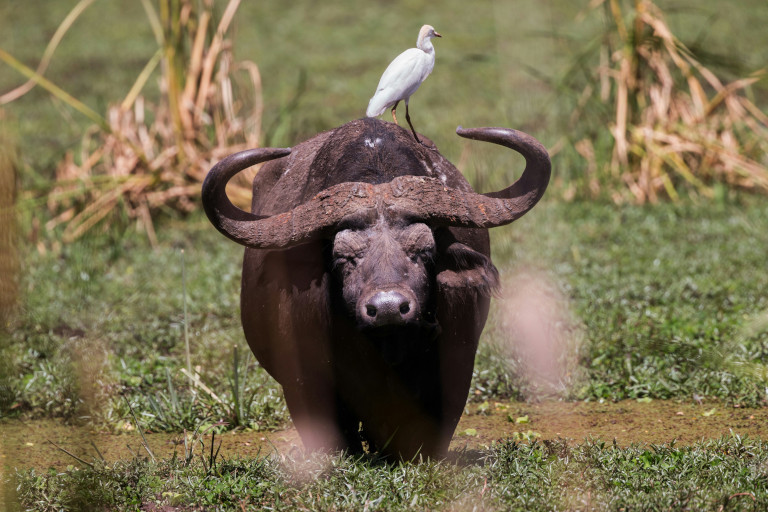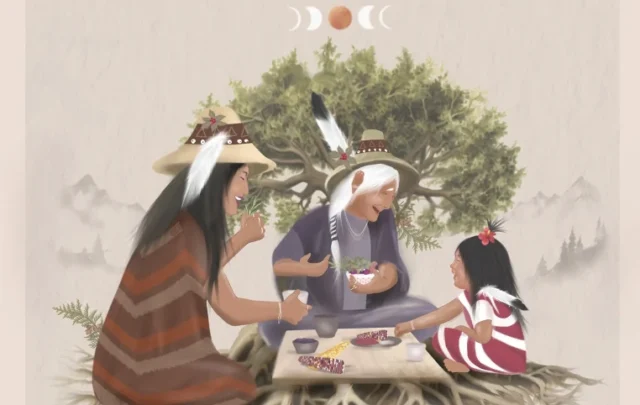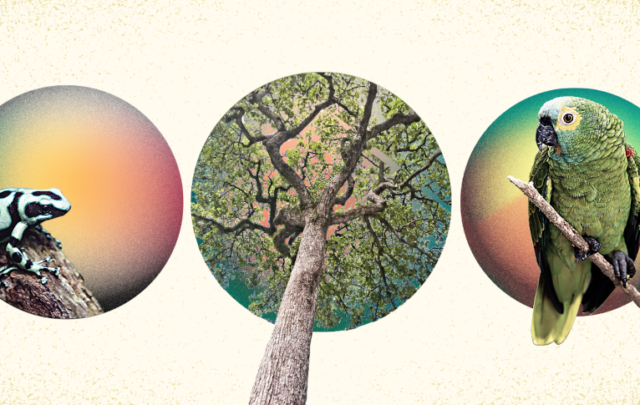What a delight to encounter the work of the British artistic duo Cooking Sections, two British artists whose virtuoso artworks effortlessly blend art with activism, local commoning, and eco-stewardship in the service of climate-friendly foodways.
Alon Schwabe and Daniel Fernández Pascual — Senior Research Fellows at the Royal College of Art in London – create distinctive works of art about modern food that are also enmeshed in the fabric of everyday life: land, intertidal waters, restaurants, buildings, social festivals. The canvas for their art is large and unconventional: the bioregional theaters of the world where food is grown and harvested, from Scotland and Istanbul to southern Italy and South Korea, and beyond.
Cooking Sections’ projects – exhibited at prestigious venues such as Tate Britain, Serpentine Galleries, and biennales and triennials in Taipei, Venice, Istanbul, Shanghai, and Los Angeles, among other cities – reveal disturbing insights into the nature of modern food systems. Yet their work goes beyond art and economic critique to develop ingeniously practical, locally grounded alternatives.
To learn more about Cooking Sections’ singular vision, I recently interviewed Alon Schwabe and Daniel Fernández Pascual for my Frontiers of Commoning podcast (Episode #50).
In recent years, Schwabe and Fernández have mounted a series of art installations, performances, and videos under the thematic title, CLIMAVORE – “How To Eat As Humans Change Climates.” While I’m no art critic, I daresay the full, rich character of their vision for food is so advanced that it has yet to be fully understood and, shall we say, digested by the culture.
If international bodies produce scientific data on climate change, Cooking Sections’ art jolts our consciousness and perceptions. Then the artists go farther, beyond art, to enlist people to work together to develop better food systems and eco-restorative local economies.
The group’s 2020 exhibit, Salmon: A Red Herring, explored the “deceptive reality of salmon as a color and as a fish,” a change driven by climate change and commercial aquaculture (fish farming). Salmon raised in fish farms have a grey flesh, so their corporate overseers add synthetic pigments to salmon feed to make the fish more appealing to global consumers – light pink for Swedish consumers, a darker pink for Japanese consumers.
“The climate crisis is not only kind of a crisis in weather,” Alon Schwabe notes. “It’s also about the ways we see the world. The colors in the world that we have perceived for centuries are literally changing – and this extends to the ways we smell and taste as well, because the chemical and biological composition of the world is changing.”
Here’s where Cooking Sections shows the strategic savvy of visionary climate activists. In the course of exhibiting in prestigious British museums, Cooking Sections has persuaded 21 of them to remove farmed salmon from the menus of their cafés and restaurants. They’ve also gotten museums to introduce alternative CLIMAVORE dishes made with ingredients that improve soil and water quality, and cultivate marine habitats.
The through-line of so many Cooking Sections artworks is commentary on the ecological impacts of global capitalism. The artists have declared that their work is about “framing our diet within a globally financialized landscape, and challenging large-scale agribusiness groups dictating what is to be produced and consumed….” The work of CLIMAVORE exhibitions “critically questions the geopolitical implications behind the making of climate alterations and the pressures they enforce on humans and nonhumans alike.”
A 2019 gallery exhibition in New York City, Offsetted, displayed a series of dismembered trees, branches and leaves hanging from the ceiling, dramatizing the grotesque implications of financializing nature. The exhibit drew attention to public policies that let corporations and financiers monetize the “environmental services” of nature and convert them into tradeable assets. Some 678,183 trees in New York City at the time were valued at $109,625,536.06 – their putative value as marketable offsets for habitat-harming economic growth.
The point of Offsetted was to take issue with the idea of conscripting nature to serve as farcical monetized offsets to the emissions, waste and pollution caused by capitalist growth. Trees can no longer be trees, the artists complained; they must be converted into “natural capital” so that they can “perform as speculative assets in real estate development and environmental mitigation.”
One of the more ambitious current CLIMAVORE projects is called Being Shellfish: The Architecture of Intertidal Cohabitation. Based on the Isle of Skye in Scotland, this long-term project is at once a work of art, community organizing, capitalist critique, and local commoning. Working with local residents, scientists, and politicians, Schwabe and Fernández are trying to replace local salmon farms, which are destroying the coastal ecosystem, with new sorts of community-managed “intertidal commons.”
The overall goal is to re-imagine local food production and consumption to take account of climatic phenomena (flash foods, drought, pressures on nonhuman creatures) in locally integrated ways. This involves recruiting local people to embrace their distinctive local foodways and try to integrate them into the local economy through new types of building materials and bioregionally based supply chains, for example.
On the Isle of Skye, Schwabe and Fernández have worked with local restaurants to remove farmed salmon from their menus. They’ve also helped develop training and support to young chefs to make CLIMAVORE dishes. A course syllabus on local food has been developed for the town’s high school.
To help residents understand the importance of the island’s intertidal waters, Schwabe and Fernández in 2017 built an installation of seats and tables made out of metal seafood cages. They explain: “Each day at low tide, the installation emerges above the sea and functions as a dining table for humans, with free tastings of recipes featuring ocean cleaners: seaweeds, oysters, clams and mussels. At high tide, the installation works as an underwater oyster table.”
The installation functions as a very special type of public forum — a multispecies intertidal table, one might say. It’s a place where local residents, sitting amidst coastal creatures in their habitat, can “envision environmentally regenerative and socially reparative forms of food production based on metabolic interactions between humans and depleted landscapes that benefit a plethora of species.”
Promoting consumption of bivalves like oysters and mussels at restaurants, while ecologically supportive, also results in a great deal of shell waste. This problem spurred Schwabe and Fernández to work with a local stonemason to recover and improve upon old methods for grinding bivalve shells into powder, and then make them into beautiful tiles. The shell-based tiles are now being used as a locally sourceable building material and as tiles for breathtaking public murals in local schools and community halls.
With creativity and initiative, a problem has been turned into a locally sustainable solution, as maintained through commoning within the community.
In other regions of the world, Cooking Sections is exploring how new food systems might emerge from the ruins of extractive capitalist practices.
In dry microclimates of southern Italy, a climate-induced “monoculture meltdown” in farming is worsening. There just isn’t enough water. So Schwabe and Fernández are helping farmers develop alternative local crops more suited for drought conditions.
In Turkey, mega-infrastructure projects have drained wetlands and fragmented grazing commons, endangering water buffaloes, their herders, and many species. A Cooking Sections’ project there is trying to celebrate the native foods and ecological heritage of the wetlands by mounting a water buffalo festival. Featured dishes of yogurt, kaymak and sütlaç are made with buffalo milk.
If art is about limning truths that we may not wish to entertain, CLIMAVORE artworks and activism provoke us to consider new ways of eating, structuring the food economy, and encouraging local participation in the transformation.
The answers that Cooking Sections have found are varied: adopting drought-resistant crops; eating bivalve, water-filtering organisms from intertidal waters; developing new building materials from shellfish waste; and using local grains to create warm, breathable thatching for roofing. Local landscapes have a lot offer if we open ourselves up to their possibilities.
What impresses me about Cooking Sections’ art and activism is their ability to show that climate change is not something distant and abstract, something that politicians and experts will somehow take care of. The CLIMAVORE work shows that climate is utterly personal and local. It is here and now, and it demands our personal attention and commitment, our imagination and resolve. What a gift to have this transformation publicly celebrated through great art!
You can listen to my podcast interview (Episode #50) with Alon Schwabe and Daniel Fernández Pascual of Cooking Sections here.






